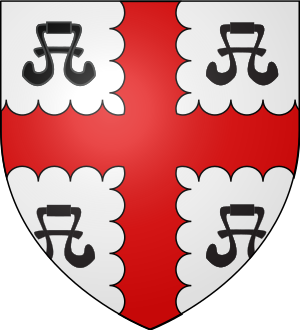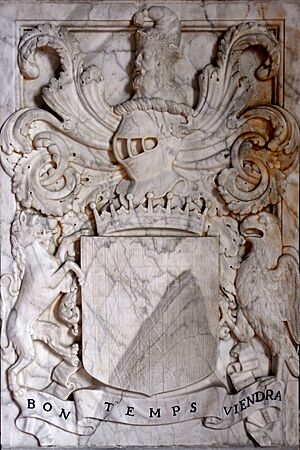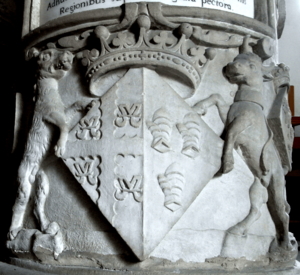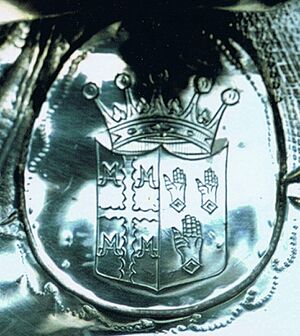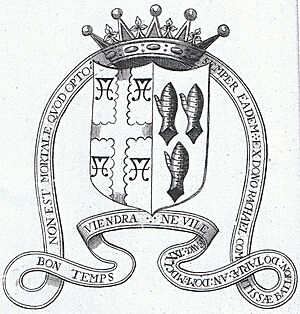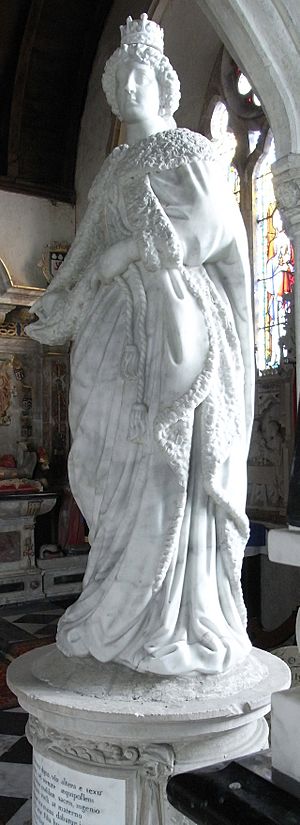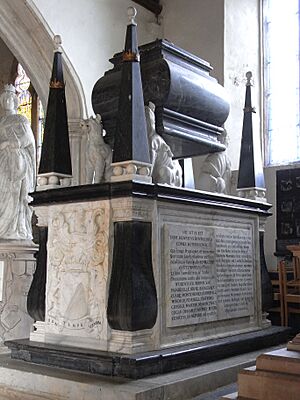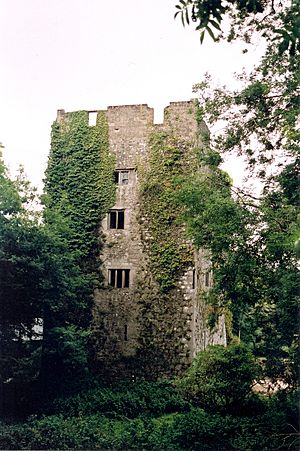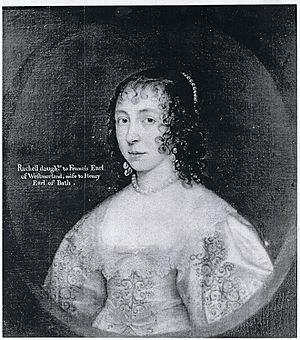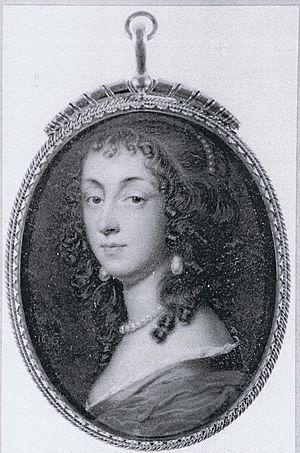Henry Bourchier, 5th Earl of Bath facts for kids
Quick facts for kids
Henry Bourchier, 5th Earl of Bath
|
|
|---|---|
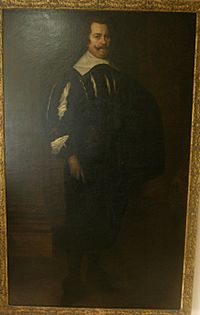
Henry Bourchier, 5th Earl of Bath, portrait c. 1638–1643, private collection.
|
|
| Born | 1587 |
| Died | 16 August 1654 Tawstock, Devon, England
|
| Spouse(s) | Rachel Fane |
| Parent(s) | Sir George Bourchier Martha Howard |
Henry Bourchier, 5th Earl of Bath (born 1587 – died 16 August 1654) was an important English nobleman. He lived in Tawstock, Devon, and held the important job of Lord Privy Seal. He owned a lot of land in Ireland (in Limerick and Armagh counties) and in England (in Devon, Somerset, and other places).
In 1637, he inherited the title of Earl of Bath from a distant cousin. He then moved from Ireland to Tawstock Court in Devon. He wasn't from Devon and didn't know many people there. As the most important nobleman living in Devon, he was expected to lead the Royalist side in the English Civil War. However, before the war truly began, he was captured in 1642. He was put in prison by the Parliamentarians before he could gather his local forces.
Contents
Early Life and Family
Henry Bourchier was born in 1587, probably in Ireland, where he grew up. He was the fifth son of Sir George Bourchier (who died in 1605). George was an English soldier who settled in Ireland. Henry's grandfather was John Bourchier, 2nd Earl of Bath (1499–1561) from Tawstock.
Henry's mother was Martha Howard (around 1555–1598). Her father was William Howard, 1st Baron Howard of Effingham. This meant Henry's uncle was Charles Howard, 1st Earl of Nottingham, who was a very important naval leader called the Lord High Admiral.
Education and Learning
Henry went to Trinity College Dublin, a university his father helped to start around 1597. He earned his first degree (BA) in 1605. In 1606, he became the 21st Fellow of the college. He received his master's degree (MA) in 1610. He was one of only a few students in the college's early years who chose not to become a priest.
Inheriting Land and Titles
Many of Henry's older brothers died young. His fourth brother, Sir John Bourchier (who died in 1614), had been a Member of Parliament for County Armagh. By 1614, Henry had inherited over 18,000 acres (73 square kilometers) of land in Ireland from his father and brother.
Then, in 1636, he became the 5th Earl of Bath. This happened after his cousin, William Bourchier, turned down the title. With this, Henry added the Bourchier family home, Tawstock, in Devon, and 36 other large estates in Devon and Somerset to his name.
Public Service and War
Henry was made a knight on 9 November 1621. He was also appointed to the Privy Council on 8 August 1641. The Privy Council was a group of advisors to the King.
Role in the Civil War
When the English Civil War began, Henry Bourchier was the most important Royalist leader in Devon. Even though he wasn't born in Devon, people expected him to have a lot of influence because of his high rank. In June 1642, his staff moved his belongings from his London home to Tawstock in Devon. They were told to travel lightly to avoid drawing attention.
On 19 July 1642, King Charles I gave Henry Bourchier and 27 other nobles a special order called a commission of array. This was a way for the King to try and take back control of the local army, called the militia. Parliament had tried to control the militia themselves, without the King's permission. The commissioners were supposed to organize and train local forces to defend the kingdom.
Bourchier arrived in Devon in August 1642. His first step was to visit the Exeter Assizes (a court meeting). People were polite but not very excited about his efforts. The local people saw the King's order as an attack on them. They ignored the Royalist idea that it was just a defense against Parliament's actions. These two different orders caused a lot of tension in the county.
On 13 August 1642, Bourchier tried to calm things down. He published his commission of array and stated that he was not doing anything illegal or harmful. He also tried to assure people that the commission was not a way to collect new taxes, as some rumors claimed.
Another commissioner, Richard Culme, tried to read his commission in Cullompton. But he faced strong opposition from the community. When Bourchier suddenly appeared with some of his soldiers, the people became very worried and started to arm themselves.
Bourchier then visited South Molton. He hoped to read his commission there and gather troops. He even sent his cook ahead to prepare a meal for the mayor and town leaders. However, on 13 September 1642, Bourchier and other Royalist gentlemen entered South Molton. They were met by an angry crowd of over 1,000 people. This mob was armed with various weapons like muskets, clubs, and pikes. They were very angry and threatened to harm anyone who tried to read the commission.
Arrest and Imprisonment
On 15 August 1642, Bourchier refused an order from the House of Lords to attend Parliament. He said he wanted to avoid the "interruptions and threats" he had faced before in London. This was seen as him breaking away from Parliament. On 23 August, the House of Lords ordered his arrest.
After some delay, during which Bourchier continued to recruit for the King, he was arrested. This happened peacefully at his home, Tawstock Court, at 11 pm on 28 September 1642. He was arrested by a Parliamentarian captain and his soldiers. He was immediately sent to prison in the Tower of London.
Release from Prison
While in prison, Bourchier asked many people, including the King, for his release. His wife, Rachel, also helped by writing to the Queen to assure her of their loyalty. One morning, his jailers searched him and took letters from his wife. He argued that letters between a husband and wife should be private.
He was released on 4 August 1643. However, he was told he had to go live in another country and not help the King. He ignored these rules. Two days after his release, he wrote to the King and traveled to the royal court in Oxford. In October 1643, he wrote to his wife in Devon. He asked her to remember him to anyone "worth the remembering," showing he was disappointed with his former friends and neighbors in Devon who supported Parliament.
On 22 January 1644, the King appointed him Lord Privy Seal in the Oxford Parliament. This was the same job his grandfather had held many years before. He kept this job for the rest of his life. In 1644, he was also made a Commissioner for the Defense of Oxford.
In the summer of 1644, as the Parliamentarian army approached, Bourchier and his wife fled from Tawstock to Cornwall. Some Royalists criticized him for leaving his post. He said he feared for his safety and had a right to leave. However, he also claimed he went to Cornwall to check on one of his estates that wasn't doing well.
In June 1645, Prince Charles (who later became King Charles II), then 15 years old, visited Bourchier at Tawstock Court. This visit is recorded in the old household records. The records show that special foods like lobsters, artichokes, and raspberries were bought for the occasion. Cooks and musicians from the Prince's own staff were also paid.
Life During the Commonwealth
During the time known as the Commonwealth of England (when England was a republic without a king), Henry Bourchier was considered a "delinquent." This meant he was seen as someone who had acted against Parliament. In December 1648, a committee in Devon accused him of five main things:
- He had left the House of Lords and fought against Parliament.
- He had actively worked for the King's commission in Devon and Cornwall.
- He had lent money to the King.
- He had attended the King's assembly in Oxford.
- He had accepted the King's job as Lord Privy Seal.
He was forced to pay money to the government for his actions. His old household accounts show he made regular payments for this. In November 1648, an inventory was made of everything inside Tawstock Court. This list still exists and tells us a lot about how this grand house was arranged. The house later burned down and was rebuilt.
Henry Bourchier died in 1654. So, he did not live to see the King return to power in 1660, an event known as the Restoration of the Monarchy.
Marriage and Family
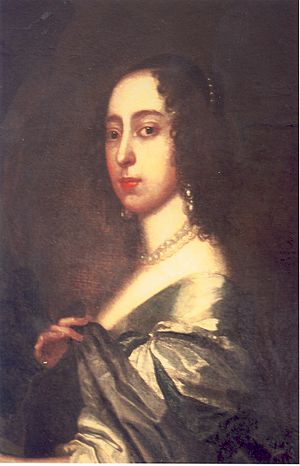
On 13 December 1638, when he was 50 years old, Henry Bourchier married 25-year-old Rachel Fane (1612/13–1680). They were married at St Bartholomew the Great church in London. Rachel was the fifth daughter of Francis Fane, 1st Earl of Westmorland. Henry and Rachel did not have any children.
Monuments
There is a monument to Rachel in St Peter's Church, Tawstock, in Devon. It is a white marble statue of a woman standing.
Henry's widow, Rachel, built a large monument to him in the south aisle chapel of Tawstock Church. Some people have called it "splendid," while others have found it "massive and ugly." It has a base of black and white marble with four white marble dogs. These dogs support a large, black, square stone coffin. At each corner, there is a black obelisk (a tall, thin stone pillar). The sides of the base have a long message written in Latin.
Succession and End of a Title
When Lord Bath died without children, the title of Earl of Bath ended. His lands in Ireland went to his widow, Rachel. From her, they passed to her nephew, Sir Henry Fane. Later, these lands went to Henry's son, Charles. Because of this inheritance, Charles was given new titles in 1718: Viscount Fane and Baron Loughguyre.
The English estates in Devon, including Tawstock, went to the Wrey family. This family was related through one of the three daughters of the 3rd Earl of Bath.
Homes and Estates
From 1640, Henry lived in Bath House, a large London home, in Lincoln's Inn Fields. His main home in Devon was Tawstock Court, in Tawstock.
He also had other homes: Clare Castle, near Tandragee, in County Armagh, Ireland. And Bourchier Castle, in Lough Gur, near Bruff, Limerick, Ireland. Bourchier Castle is a tower house that still stands today. Clare Castle, which was a large fortified stone house, is now a ruin.
Vast Land Holdings
Henry's estate in County Limerick was huge, covering about 12,800 acres (52 square kilometers). It included the areas of Lough Gur and Glenogra. These lands were originally given to his father, Sir George, by Queen Elizabeth I in 1589.
Around 1718, this estate was described as having:
- The manor of Loughguyre & Glenogre
- 5 castles
- 300 large houses
- 1500 small cottages
- Many other buildings and lands, including thousands of acres of fields, meadows, pastures, and woods.
Most of his land in Armagh, at least 6,000 acres (24 square kilometers), was given to his elder brother John in 1610. Henry bought more land in County Armagh in 1646. Part of the Armagh estate, called Brackagh Bog, is now a Nature and Moss Reserve.
By 1805, when the Irish estate was divided among heirs, it still included about 6,620 acres (26.8 square kilometers) in County Limerick and 6,908 acres (27.9 square kilometers) in County Armagh.
Household Records
Old household account books from the Earl and Countess of Bath still exist. They show some of the things Rachel, the Countess, ordered:
- In June 1640, she paid for a picture of her cousin, Lady Peterborough.
- In May and June 1641, she paid the famous painter Sir Anthony Van Dyck for her own portrait and its frame. Van Dyck died later that year.
- In November 1641, she paid another painter, Peter Lely, for a copy of one of her pictures.
- Later, in 1646, she paid Lely for more paintings and a copy of her portrait.
Oswald Barron, a writer from 1905, described Rachel as a "great lady and a busybody." He said her many relatives respected and feared her. She was a strong woman who helped her family members get ahead in society.
|


